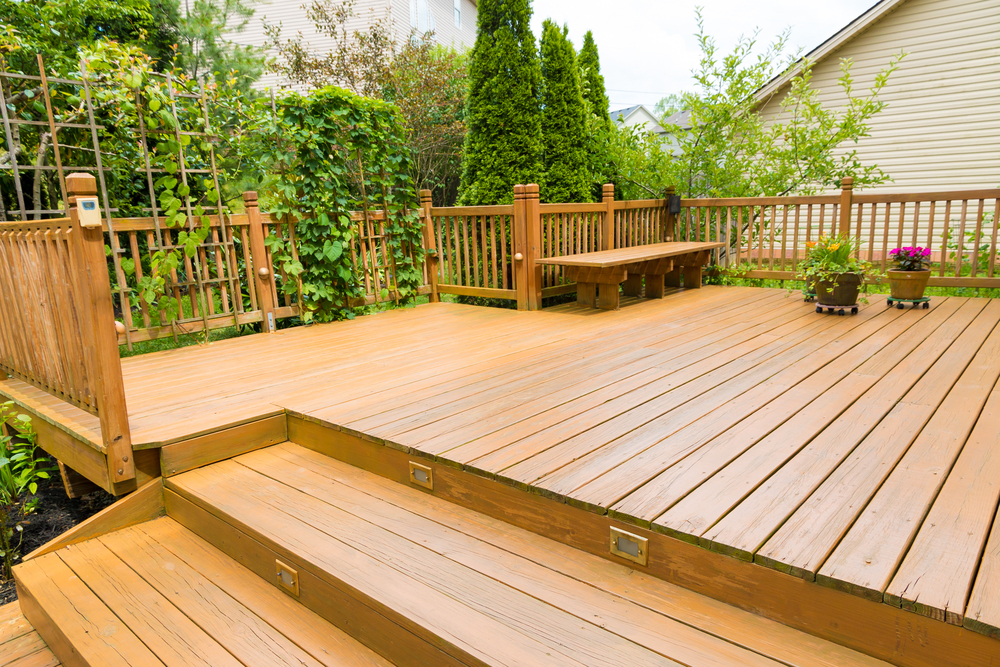Your Garden Steps Building Guide
Not all of us are lucky enough to have an outdoor space which is all on the same level.
Although there is nothing wrong with a gently sloping garden, if the gradient is too steep then the garden becomes almost impossible to use effectively.
One of the best ways of dealing with a garden which slopes is to have different sections of the garden at different levels, and to link these sections using steps.
Preparation

The first part of any job in the garden or house is to take time out to prepare and think about what the end effect should be.
Factors to consider include issues such as where in the garden the steps are to be located, what sort of material is going to be used to make the steps, how wide they are going to be and whether any sort of hand rail is going to be needed for support.
The most common type of material used to make garden steps is bricks which are resistant to frost, and these can be bought from all major DIY stores.
Measuring
When laying steps on a slope, start by measuring the height and the length of the slope.
As each brick is 200mm high, this will help you work out how many steps you will have in the flight.
Measuring the length of the slope will help you work out how deep each step is going to be, assuming you want to have your steps all equally sized.
Take time over this stage and mark out exactly where the steps are going to be with pegs and string.
For beginners, stick to a straight flight of stairs and leave the sweeping staircases with intricate brickwork to the professional bricklaying services.
Foundation
Starting at the top of the slope, dig out rough step shapes using a garden spade.
This is the hard labour part of the process and it will be much quicker to complete if you are able to rope in some friends or family to help with the digging.
At the bottom of the flights of steps, lay the foundation layers of bricks.
Check the alignment of the bricks with a spirit level as mistakes at this stage will mean that the rest of the stairs are not square either.
Set the bricks in cement and leave them to dry thoroughly, preferably overnight. If the weather is damp, cover the bricks with a plastic sheet while they dry.
Completing the Steps
Once the first layer of bricks has been completed, continue setting the risers and the steps themselves up the slope.
Check how square each brick is with your spirit level before moving on to the next step.
Secure them with mortar as you go. For a gentle slope, paving slabs can be used to form the step and bricks can be used for the risers.
Once all of the bricks have been laid, they have to be allowed to dry thoroughly before anyone uses the steps.
10 Frequently Asked Questions About Building Garden Steps
Garden steps not only improve accessibility on sloped or uneven ground, but they also enhance the look and structure of your outdoor space. Whether you're planning a new set of steps or replacing old ones, understanding the basics is essential. Below are the most frequently asked questions—answered clearly for beginners and experienced DIYers alike.
1. Do I need planning permission to build garden steps?
Usually not.
In most cases, garden steps don’t require planning permission if they are:
-
Built within your property boundary
-
Not part of a raised platform over 30 cm high
-
Not affecting public access or rights of way
However, if your property is listed or within a conservation area, or if the steps are part of a retaining wall, it's best to check with your local planning authority.
2. What materials can I use for building garden steps?
Common choices include:
-
Concrete – durable and low maintenance
-
Bricks or pavers – great for blending with existing features
-
Timber sleepers – rustic and natural-looking
-
Natural stone – attractive but more expensive
-
Gravel and risers – for informal or rural gardens
Choose materials that complement your landscape and are weather-resistant and non-slip.
3. How deep and high should each step be?
A comfortable step typically follows the rule of:
-
Riser (height): 150mm–170mm
-
Tread (depth): 250mm–300mm
This ratio provides a balance between comfort and safety. Try to keep all steps uniform in size to avoid tripping hazards.
4. How do I calculate how many steps I need?
Follow these steps:
-
Measure the total height (rise) from the bottom to the top level.
-
Divide this by your intended step height (riser) to get the number of steps.
-
Adjust slightly if needed to ensure even spacing and comfortable sizing.
For example, if your total rise is 900mm and each step is 150mm, you'll need 6 steps.
5. Do I need foundations for garden steps?
Yes—especially for permanent steps made of concrete, brick, or stone.
-
Excavate a trench and add a sub-base of compacted hardcore or MOT type 1.
-
Top it with a layer of concrete footing to provide a stable base.
-
For timber steps or gravel steps, a compacted sub-base may be enough.
Proper foundations prevent movement, subsidence, or cracking over time.
6. How can I make garden steps safe and slip-resistant?
Safety tips include:
-
Choose non-slip materials or add grip strips
-
Ensure steps are evenly spaced with consistent riser and tread dimensions
-
Install handrails if the steps are steep or more than 4–5 risers
-
Consider drainage to prevent water pooling and algae growth
In shaded or damp gardens, textured surfaces help prevent slips.
7. Can I build steps into a slope without a retaining wall?
Sometimes.
If the slope is gentle, you can build steps by cutting into the earth and installing risers (e.g. sleepers, bricks). For steeper slopes, you’ll likely need:
-
Retaining walls at each step level
-
Extra structural support to hold back soil
Retaining structures also help prevent erosion and collapse.
8. Should garden steps be straight or curved?
Both are possible—it depends on your space and style.
-
Straight steps are easier to build and suit formal gardens.
-
Curved or angled steps blend naturally into sloped or informal garden landscapes but require more planning and precision.
Curved steps may need more cutting and shaping of materials and careful layout.
9. How much does it cost to build garden steps?
It varies widely depending on materials and complexity:
-
DIY timber steps: £80–£200
-
Brick or concrete steps: £250–£500
-
Natural stone steps (professional): £600+
Labour, tools, and groundwork can add to the cost. For a DIY project, having the right tools and prepping thoroughly helps manage the budget.
10. Can I build garden steps myself or do I need a professional?
You can, if you:
-
Are confident with measuring, levelling, and basic masonry or carpentry
-
Understand how to build a solid base and safe structure
-
Have the necessary tools (spade, level, mixer, saw, etc.)
If your site has:
-
Poor drainage
-
Steep terrain
-
Complex landscaping needs
…it’s a good idea to consult a landscape gardener or builder.
🧰 Final Tip
Always plan your project on paper first, including measurements, materials, and quantities. A little time spent planning will save a lot of time (and cost) during construction.
